Gold, Guns and God: Vol. 2—A Pioneer Community
A Biography of Swami Bhaktipada and a History of the West Virginia New Vrindaban Hare Krishna Community in Ten Volumes by Henry Doktorski
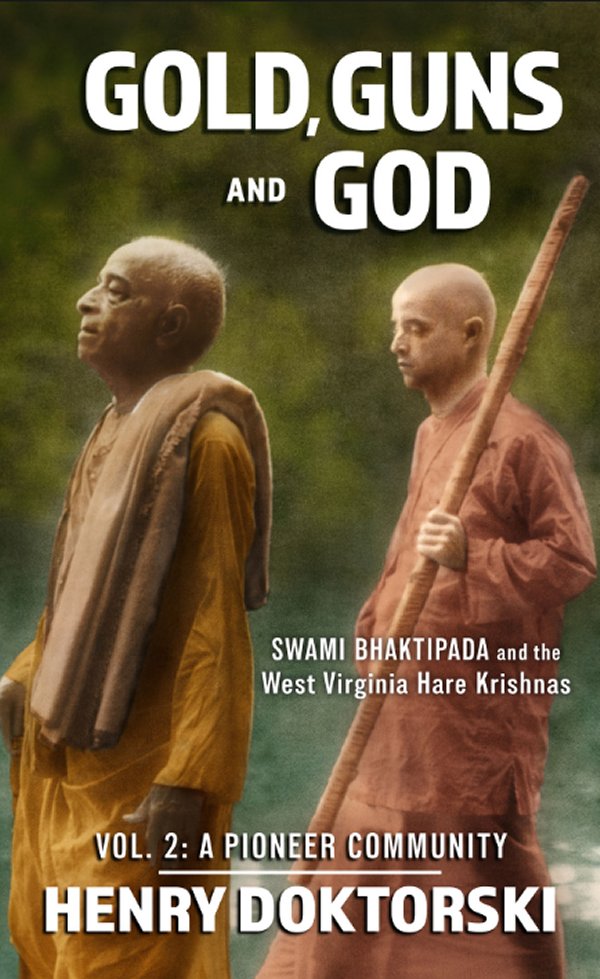
Front cover: Bhaktivedanta Swami Prabhupada and Kirtanananda Swami at New Vrindaban (September 1972)
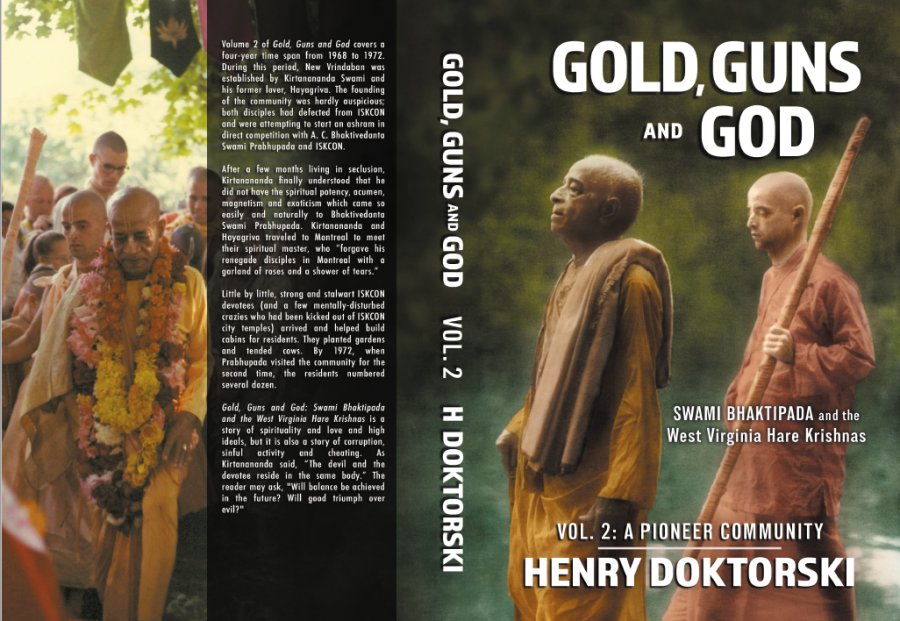
Front and back over photos p>
Henry Doktorski’s landmark 447-page non-fiction book about Swami Bhaktipada and the West Virginia Hare Krishna commune called New Vrindaban, can be purchased in several ways: (1) Save money and purchase directly from the author: Send a check or money order (or use PayPal or Venmo) for $19.99 (includes shipping to anywhere in the United States). Send an email to the author and request address. Credit card payments must go through PayPal or Venmo. Send PayPal payment to the author at the e-mail address listed below. Canadian and overseas customers can pay with Western Union and must inquire directly from the author regarding shipping prices.
(2) Purchase from eBay here. (3) In USA, purchase from Amazon.com. (4) In Canada, purchase from Amazon.ca. (5) In Mexico, purchase from Amazon.com.mx. (6) In Brazil, purchase from Amazon.com.br. (7) In Great Britain, purchase from Amazon.co.uk. (8) In France, purchase from Amazon.fr. (9) In The Netherlands, purchase from Amazon.nl. (10) In Spain, purchase from Amazon.es. (11) In Germany, purchase from Amazon.de. (12) In Italy, purchase from Amazon.it. (13) In Japan, purchase from Amazon.jp. (14) In Australia, purchase from Amazon.com.au. (15) In India, purchase from Amazon.in. (16) Kindle readers, purchase from Amazon Kindle. In addition, please “Like” Gold, Guns and God on Facebook! Vol. 2 of Gold, Guns and God covers a four-year time span from 1968 to 1972. During this period, New Vrindaban was established by Kirtanananda Swami (Keith Ham) and his former (we assume) lover, Hayagriva (Howard Wheeler). The founding of the community was hardly auspicious; both disciples had defected from ISKCON and were attempting to start an ashram in direct competition with Bhaktivedanta Swami Prabhupada and ISKCON. Years later, Kuladri (Arthur Villa), who served as the New Vrindaban temple president from 1976 to 1986, told the author, “New Vrindaban has always been the black sheep of ISKCON.” During their defection from ISKCON in 1967 and 1968, Hayagriva had kept in touch with his spiritual master (he was not as fanatically independent as his rebellious godbrother), but Kirtanananda, on the other hand, had completely severed and abandoned his relationship with Bhaktivedanta Swami Prabhupada and ISKCON. In his heart, it appears, Kirtanananda wanted to become a big guru himself, and he pursued his grandiose dream to the best of his abilities. Unfortunately (or perhaps fortunately), Kirtanananda discovered that he could not attract spiritual seekers to even visit his “ashram” in a rundown, nineteenth-century farmhouse without running water, electricity, or even insulated walls, in the hilly backwoods of Marshall County, West Virginia. The frigid winter winds blew through the cracks in the walls. The farmhouse was isolated at the end of a two-mile mud road which was inaccessible, except possibly for the most-powerful four-wheel-drive vehicles. After a few months living in seclusion, Kirtanananda finally understood that he did not have the spiritual potency, acumen, magnetism and exoticism which came so easily and naturally to Bhaktivedanta Swami Prabhupada. While Kirtanananda suffered in isolation at the remote farmhouse in the Allegheny Plateau, ISKCON had been expanding by leaps and bounds. Prabhupada’s many disciples had established vibrant and dynamic preaching centers in Boston, Buffalo, Hollywood, London, Montreal, New York City, San Francisco, Santa Fe and Seattle. Kirtanananda was forced to admit defeat, swallow his pride, grovel at the feet of Bhaktivedanta Swami Prabhupada, and beg forgiveness. He and Hayagriva traveled to Montreal to meet their spiritual master, and Prabhupada “forgave his renegade disciples in Montreal with a garland of roses and a shower of tears.” Although Richard Rose, the owner of the Marshall County, West Virginia property, refused to grant long-term leases to tenants, Kirtanananda and Hayagriva encountered a stroke of luck when Rose ran into grave legal problems and needed immediate cash to hire a lawyer. Rose reluctantly agreed to lease his 132.77 acres property to Keith Ham and Howard Wheeler for ninety-nine years for four thousand dollars, with an option to purchase for ten dollars when the lease expired. Hayagriva put down a $1,500 deposit. After the lease was signed, Bhaktivedanta Swami Prabhupada approved of the West Virginia New Vrindaban ashram as a bona fide ISKCON project, and gave instructions for its development. New Vrindaban, he explained, was to become a self-sufficient, agricultural community dependent not on industry, but on farming and dairy cows. The residents would worship the Supreme Personality of Godhead, Lord Sri Krishna, chant Hare Krishna, and eventually build seven temples named after the seven major temples in Vrindaban, India. New Vrindaban would become, as noted in the ISKCON Articles of Incorporation, “a holy place of transcendental pastimes, dedicated to the Personality of Krishna.” The first year, however, was difficult. Few ISKCON devotees came to help, and the winter of 1968-1969 was grueling. West Virginia weather could be severe, and the nineteenth-century farmhouse had no electricity, running water, nor insulation. The frigid winds blew through cracks in the walls. But the handful of stalwart residents survived the first winter, and in the spring of 1969, purchased their first cow and welcomed their spiritual master, His Divine Grace A. C. Bhaktivedanta Swami Prabhupada, who graced the humble rural ashram “inmates” with his presence for more than a month. He gave his association freely to residents and visitors, and also gave instructions on how to develop the community. Little by little, strong and stalwart ISKCON devotees (and a few mentally-disturbed crazies who had been kicked out of ISKCON city temples) arrived and helped build cabins for residents. They planted gardens and tended cows. In August 1971, large and beautiful hand-carved marble deities named Sri-Sri Radha-Vrindaban Chandra arrived, and were installed with much fanfare. Things were finally starting to look good for the two-dozen or so residents of the primitive Krishna conscious village. Soon after the installation festival for the new deities, Kirtanananda Swami left New Vrindaban and established a traveling preaching program featuring music, singing, chanting, dance, drama, lectures and prasadam (vegetarian food offered to Krishna) which became known as the “Road Show.” Talented singers, musicians and actors rehearsed, produced, promoted and performed a show which was both educational and entertaining, and eventual became known as the “Transcendental Rock Opera.” Bhaktivedanta Swami Prabhupada was pleased by the reports he heard about the preaching successes of the show. However, in Kirtanananda Swami’s absence, the New Vrindaban residents had gradually become morose, and there was talk about disbanding the community. Bhaktivedanta Swami Prabhupada became concerned, and ordered Kirtanananda Swami to return to New Vrindaban immediately, assess the damage, and institute a program to save the community. Kirtanananda immediately recognized what he believed was the source of the difficulty: the deities were being neglected. Kirtanananda Swami had the deities moved from the Vrindaban farm to the Bahulaban farm—a recently-purchased property on the main road which had become the center of the community—in a big festival. When the residents once again resumed their devout worship of Sri-Sri Radha-Vrindaban Chandra, the community was again united in love for guru and Krishna. Kirtanananda had saved the community by rekindling the Brijabasis’ love for Krishna. Unfortunately Kirtanananda Swami, with the assistance of his followers, created a “Cult of Kirtanananda.” The residents began to worship their shiksha guru (instructing spiritual master), Kirtanananda, on an equal level as their diksha guru (initiating spiritual master), Bhaktivedanta Swami Prabhupada. This co-dependent relationship might have worked if Kirtanananda had actually been a humble, self-realized, uttama-adhikari servant of his spiritual master, but this was not the case, as time later revealed. When a neophyte devotee pretends to be a self-realized soul, all havoc ensues, and Kirtanananda and his followers eventually deviated from the path of strict devotion and created their own fantasy world of pseudo-bhakti. This was, however, not apparent to most in the beginning. Even Bhaktivedanta Swami Prabhupada, when he visited New Vrindaban for the second time in August and September 1972, profusely praised his first sannyasa disciple and showered him with great affection. If Prabhupada was aware of the sinister and secret interior motives of his most-popular and charismatic disciple, he did not share his misgivings with others. In fact, during his second visit to New Vrindaban, he told his high-ranking GBC representatives that, “He [Kirtanananda] is worth ten of you.” Gold, Guns and God: Swami Bhaktipada and the West Virginia Hare Krishnas is a story of spirituality and love and high ideals, but it is also a story of corruption, sinful activity and cheating. As Kirtanananda said, “The devil and the devotee reside in the same body.” Will balance be achieved in the future? Will good triumph over evil? May 15, 2022: THE HARE KRISHNA HISTORIAN Henry Doktorski, aka Hrishikesh dasa Prabhu, has established a new territory of scholarly research with his books on “Hare Krishna History.” Hrishikesh Prabhu was very kind to print my essay on Kirtanananda Swami as a Foreword in Volume 2 of his series, Gold, Guns and God. At one point, Hrishikesh was a faithful follower of K. Swami, which explains why he is going to so much trouble to see that the truth gets out there. Although this book is technically gramya-sastra or “town news of everyday affairs,” it is still Krishna conscious. It is not a sensational “tell-all.” From what I have seen in his books, the content still leads to worship of Krishna and to the chanting of His Holy Names. He does not denigrate the teachings of Srila Prabhupada. Rather he holds to them-—which is something that the “leaders” of Guru Maharaja’s movement should have done. Had they done so, then such books could not have been written about them. His writings are meticulously researched, and his style is engaging and intelligent. He is a musician and artist, and that artistry shows in his literary pace. In the future, genuine scholars will consult these books with confidence to see what actually went on during the rise of the first and second generations of the Hare Krishna Movement. Unlike the BBT(I) in their trademark haphazard disregard for the rules of scholarship and editing, the books of Doktorski are precisely indexed with exact references to anything written in them. The Supreme Lord Himself, Shri Chaitanya Mahaprabhu has created a vast movement that has covered the world. The Lord’s movement has expanded worldwide, but with great difficulties that have directly been created by inept followers who tried to visualize themselves as spiritual leaders. Therefore, with a growing global movement at hand, the need for accurate descriptions of the past and present progress of the Hare Krishna Movement is important. Hrishikesh Prabhu has answered that need and those who seek spiritual shelter without any fear of being cheated owe him a vote of thanks. As I said earlier, in the future, scholars will refer to his books with confidence. And, it goes without saying that any devious ISKCON leaders still living can now learn a lesson by seeing what the public actually thinks of their sociopathic blunders. Thus, Doktorski’s contributions are also a stern lesson to anyone who wants to mix personal ambition with a show of spiritual elevation. These books will sit on the shelves under the Bhagavatams along with Chasing Rhinos, Miracle on 2nd Ave, and other genuine records of Hare Krishna History. People will want to know what happened, and here it is in well written black and white. Patita-Uddharana dasa (Miles Davis) Image: Patita-Uddharana on harinam in Manhattan (Summer 1969) March 10, 2022: Five Stars—Detailed Study of a Cult Pranams, Jaya Srila Prabhupada! Vol. 2 of Henry Doktorski’s Gold, Guns and God, follows Kirtanananda “Swami” on his preaching and management journey and further cements his reputation as Hare Krishna movement founder, A. C. Bhaktivedanta Swami Prabhupada’s favored disciple (“He is worth 10 of you.”). Doktorski serves up a delicious irony having been granted access to New Vrindavana’s archives and other histories and personally knowing hundreds of its “inmates” from their shared devotion to Kirtanananda. He documents not only Kirtanananda’s head inflation but the extreme pride his acolytes from among his fellow disciples felt in following him and being members of the community. Now that they have all gotten what comes around their statements are found to be deftly turned on them in what amounts to a detailed and illustrative example for all to benefit from. Vol. 2 sets the stage for what comes next in the inflation and coming around. Another interesting element of Doktorski’s series, and that this volume details, is how Kirtanananda’s cult took shape within the framework of a manifestation of a genuine and strict religious tradition, the Gaudiya Vaishnavism of Bhaktivedanta Swami Prabhupada. Kirtanananda is documented nourishing the reputation that he is the most advanced and learned of Prabhupada’s disciples, and not merely in word. This series is a trip through the brain of a very complex and extremely intelligent individual who was capable of fooling virtually everyone with his charisma, grasp of Vaishnava philosophy and persuasiveness. “There but for fortune, may go you or go I.” Eric Johanson Readers’ Letters May 6, 2021: I’m so happy! I’m relaxing on my garden hammock starting to read Gold, Guns, and God, Volume 2. Looking forward to another great read by Henry Doktorski! Barbara Michaels May 25, 2021: HARE KRISHNA HARE KRISHNA: that may spark memories of peace, saffron robes and airports, but what about murders, drugs and tax evasion? Gold Guns and God .... an ashram I spent a couple years at. Henry Doktorski is putting them out faster than I can read them. Jeff Claussen (Janardan dasa) Chapter 13: Establishing the Caste System in the Modern World Swamiji becomes Srila Prabhupada
Chapter 14: Plain Living, High Thinking Kirtanananda attempts to reconcile with Bhaktivedanta Swami Prabhupada
Chapter 15: The Prodigal Sons Return 100 brahmacharis?
Chapter 16: Hayagriva Ties the Knot Kirtanananda’s reputation for austerity becomes legendary
Chapter 17: We Must All Follow in the Footsteps of Kirtanananda First cow purchased
Chapter 18: Growing Pains New Vrindaban is closing?
Chapter 19: A Great Sinister Movement Bhaktivedanta Swami Prabhupada takes immediate action to save his Society
Chapter 20: In Every Town and Village Radha-Krishna deities acquired for the Road Show
Chapter 21: A Transcendental Rock Opera February 1972: Louisiana
Chapter 22: Under New Management An unmarried mother tied up in the barn; expelled from the community
Chapter 23: The Cult of Kirtanananda Kirtanananda’s walking cane
Chapter 24: He Is Worth Ten Of You Bhaktivedanta Swami Prabhupada returns to New Vrindaban

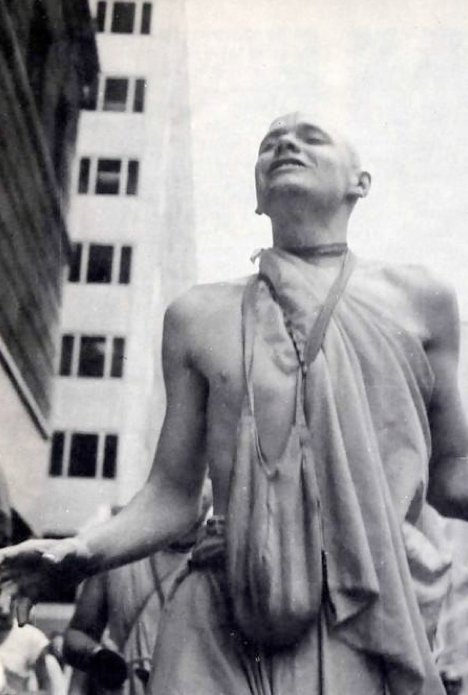
AKA Patita-Pavana dasa
Blagoevgrad, Bulgaria

Moab, Utah
Amazon review
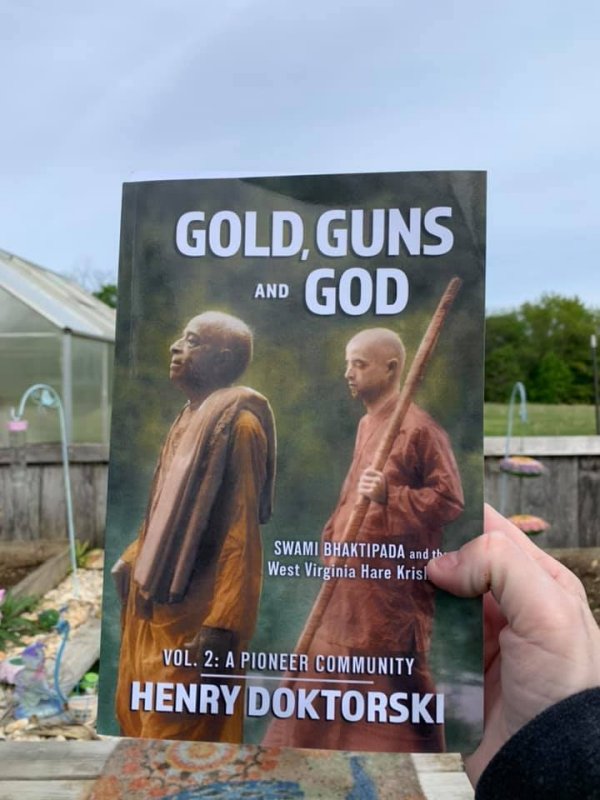
Bath, Pennsylvania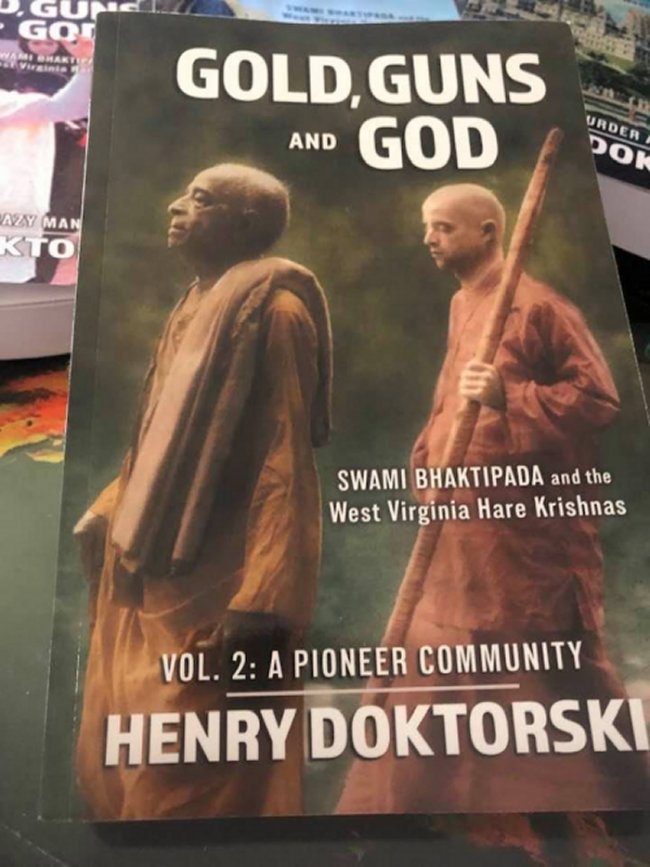

Sioux City, Iowa
Varnashram-Dharma
ISKCON farm communities
Bhaktivedanta Swami Prabhupada proposes a country ashram for ISKCON
Community camp
Swamiji proposes Pennsylvania ashram
Bhaktivedanta Swami coins the name “New Vrindaban”
A non-denominational ashram in West Virginia is proposed
Richard Rose
Kirtanananda writes to Rose
Bhaktivedanta Swami Prabhupada proposes a New Vrindaban in West Virginia
Kirtanananda and Hayagriva visit Richard Rose’s West Virginia farm
Rose achieves notoriety with help from Kirtanananda and Hayagriva
Janardan intercedes on Kirtanananda’s behalf
Hayagriva visits Bhaktivedanta Swami Prabhupada in New York
The prodigal son begs forgiveness
The main business of New Vrindaban: raising cows
Bhaktivedanta Swami Prabhupada proposes a New Vrindaban in Florida
Bhaktivedanta Swami Prabhupada orders Kirtanananada and Hayagriva to give up
The “shoot out” at Rose’s goat farm
Kirtanananda sees his spiritual master again
The lease is signed
Now we can work with great enthusiasm for constructing a New Vrindaban in the United States
Bhaktivedanta Swami Prabhupada allows ISKCON devotees to live at New Vrindaban
Little Radha-Krishna deities acquired
Hayagriva becomes president of New Vrindaban
Bhaktivedanta Swami Prabhupada asks Hayagriva to take a wife
Hayagriva refuses to marry
The marriage of Hayagriva and Shama dasi
A recipe for disaster? arranged marriages with homosexual men
Swamiji becomes widely known as Prabhupada
Bhaktivedanta Swami Prabhupada arrives in Columbus
Bhaktivedanta Swami Prabhupada and Allen Ginsberg chant at a campus engagement
Bhaktivedanta Swami Prabhupada arrives at New Vrindaban
Richard Rose meets Bhaktivedanta Swami Prabhupada
Four major purposes of New Vrindaban
New Vrindaban not different from Goloka Vrindaban
New Vrindaban better than Vrindaban, India
Reflections
“I am always thinking of your New Vrindaban”
Conflict between Kirtanananda and Hayagriva
Kirtanananda and Hayagriva’s love-hate relationship
New Vrindaban traveling preaching parties
The community expands
New Vrindaban residents begin rising early in the morning
First annual New Vrindaban Janmashtami festival
Crisis at New Vrindaban
Hayagriva leads battle against errant sannyasis
Errant sannyasis banned from ISKCON
Kirtanananda preaches in India
Pittsburgh ISKCON established
Giant Lord Jagannath appears
Incense factory established
Madhuban farm purchased
Bahulaban, Guruban farms purchased
Enmity with neighbors
Brijabasis travel to Detroit to see their spiritual master
Sri-Sri Radha-Vrindaban Chandra arrive
Hayagriva glorifies Bhaktivedanta Swami Prabhupada and New Vrindaban
August-September 1971: rehearsals begin at New Vrindaban
October-November: Atlanta
Gospel church performance
School buses purchased
Vishnujan Swami invited
Florida engagements
Tampa
December 1971-January 1972: Orlando
Deities are named “Radha-Damodar”
Road Show racism?
January 1972: Gainesville and Tallahassee
February 1972: Mobile, Alabama
Busted!
An imaginary feast
March 1972: New Orleans and Houston
April 1972: Atlanta
Blitzing small towns
Washington D. C.
May 1972: Boston
June 1972: Brooklyn, New York
Kirtanananda chants on new initiates’ beads
August-September 1972: Pittsburgh
Bhaktivedanta Swami Prabhupada asks Hayagriva to leave New Vrindaban
Hayagriva’s leadership abilities lacking
Bhaktivedanta Swami Prabhupada asks Hayagriva to edit fulltime
Kirtanananda diagnoses the problem at New Vrindaban
Radha-Vrindaban Chandra move to Bahulaban
Hayagriva resigns
The formation of the New Vrindaban Governing Board
Kirtanananda had the last say in everything
Kirtanananda repeats purely the message of Bhaktivedanta Swami Prabhupada
Kirtanananda highly respected throughout ISKCON
Bhaktivedanta Swami Prabhupada shows confidence in Kirtanananda
Kirtanananda’s charismatic authority
The uttama adhikari
Janmashtami festival
Bhaktivedanta Swami Prabhupada’s birthday celebration
Bhaktivedanta Swami Prabhupada exhibits symptoms of ecstasy
Bhaktivedanta Swami Prabhupada’s cake destroyed by “wild animals”
“Kirtanananda is worth ten of you”
Road Show performance at New Vrindaban
Road Show disbanded
Images
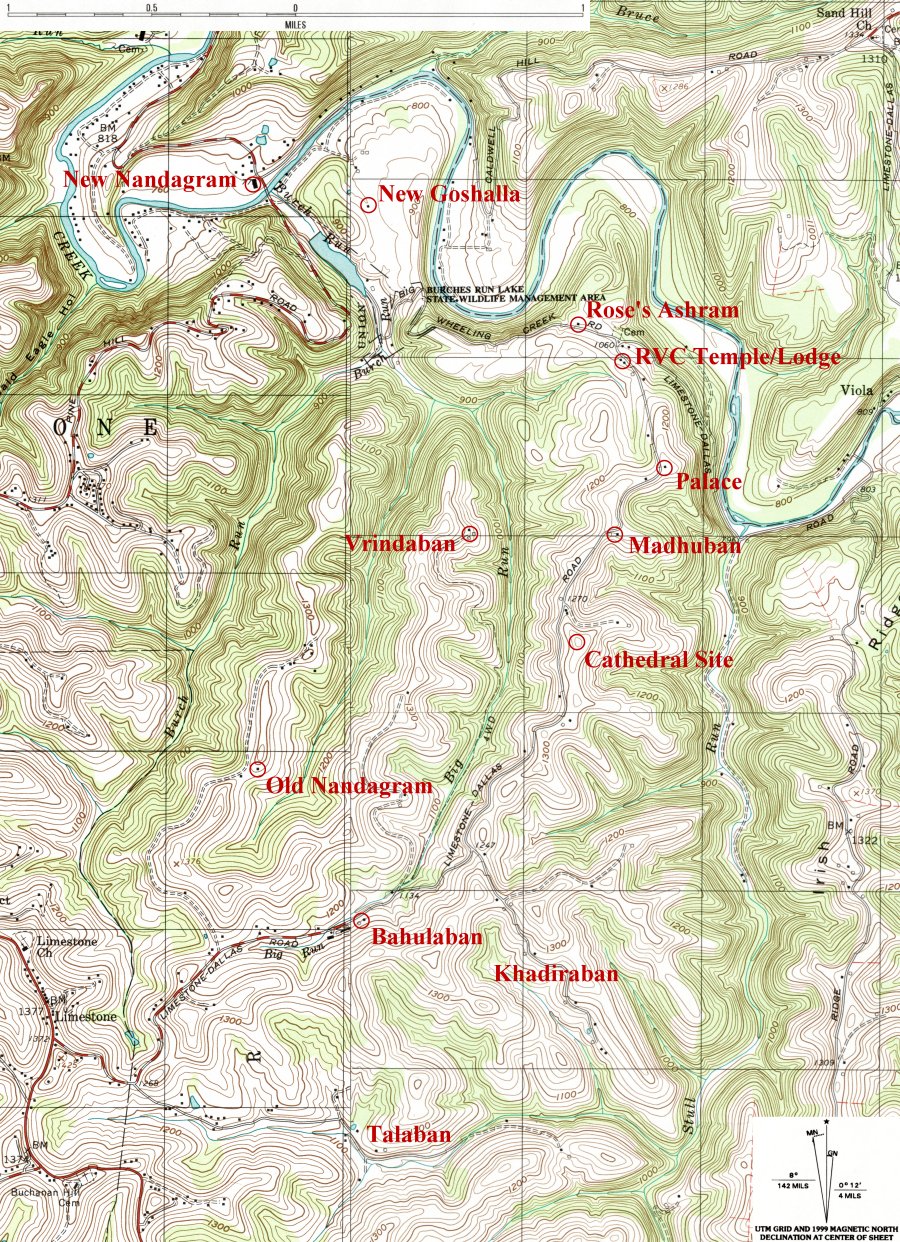
U. S. Geological Survey topographic map of McCreary Ridge showing location of principle sites of New Vrindaban.
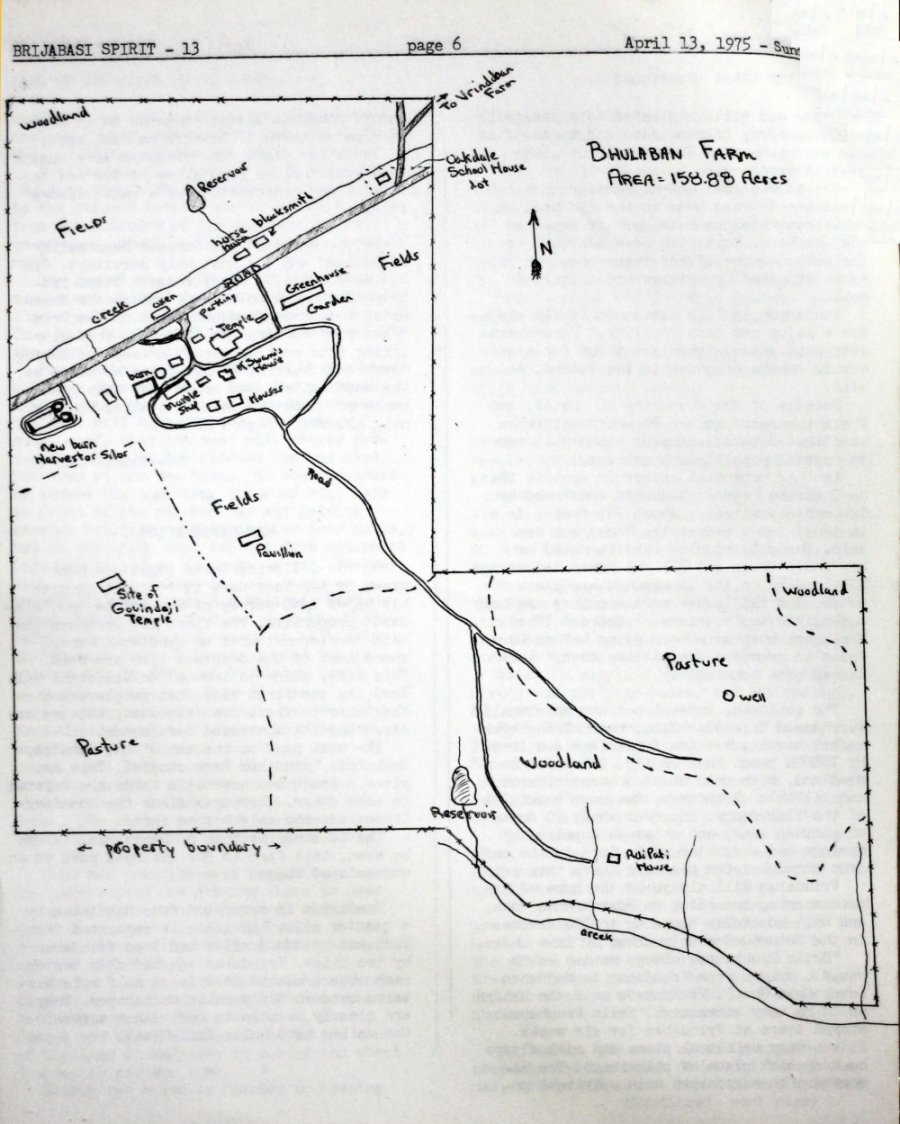
Map of the Bahulaban farm, showing location of the temple, the old barn, Kirtanananda Swami’s cabin, and the site of the proposed Govindaji temple.
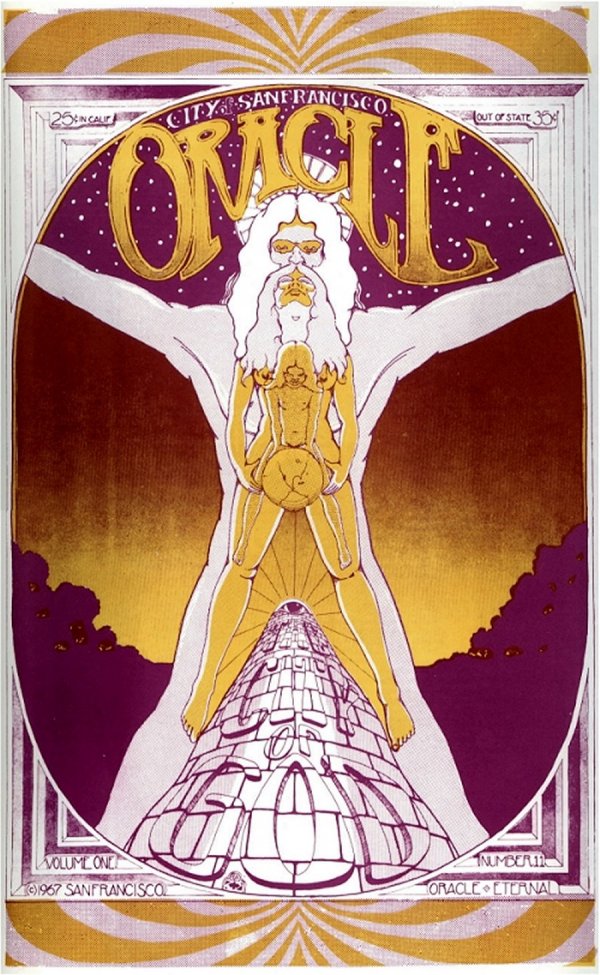
Cover of the December 1967 issue of the City of San Francisco Oracle.
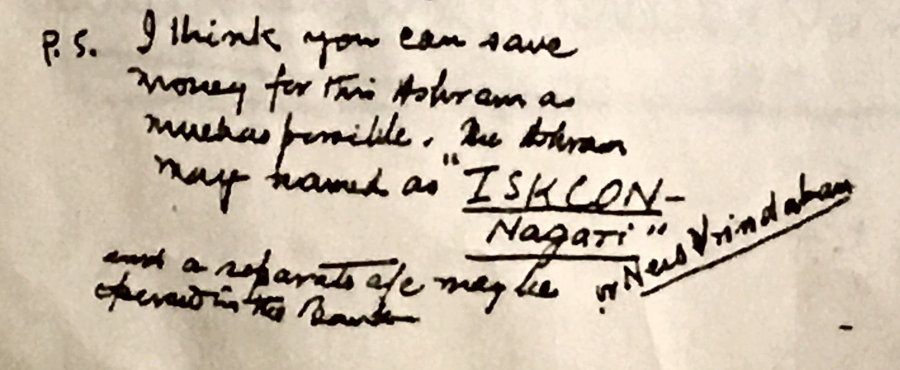
Handwritten postscript depicting the first known appearance of the words “New Vrindaban.”—Bhaktivedanta Swami Prabhupada, letter to Hans Kary (Hansadutta) (January 22, 1968).
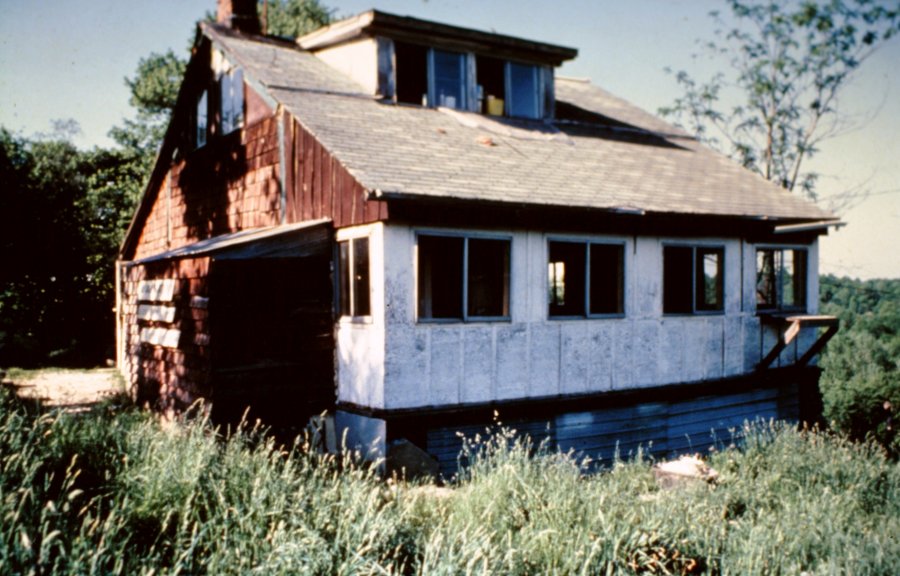
Vrindaban farmhouse (undated).
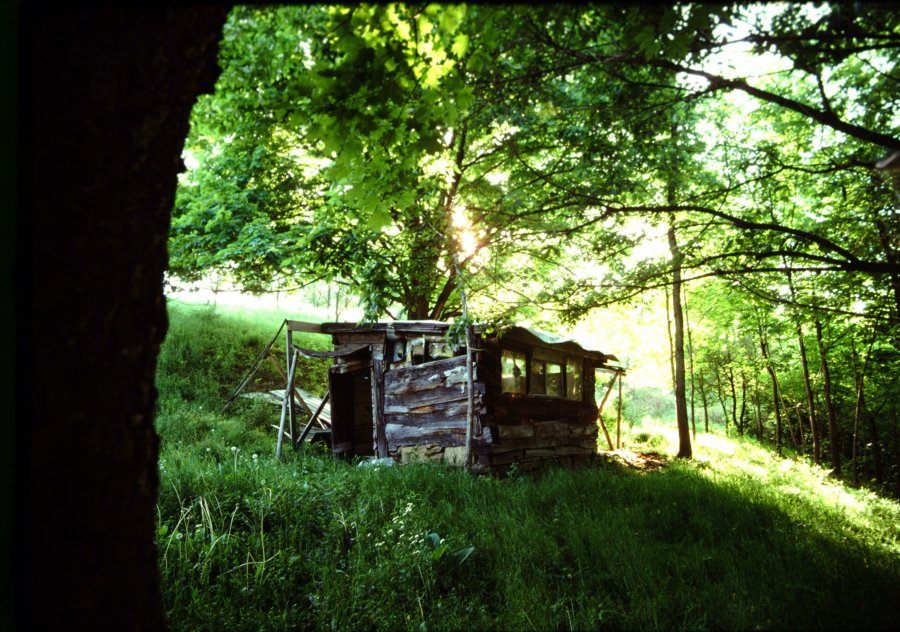
Abandoned chicken coop, where Kirtanananda reportedly lived for a while.
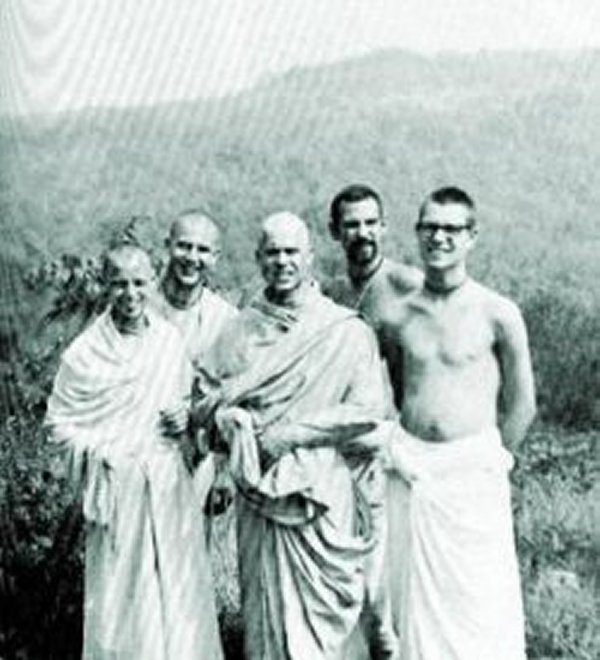
Kirtanananda Swami, Vamanadev, Hrishikesh (Harold Olstead), Hayagriva and Pradyumna (Paul H. Sherbow) at New Vrindaban (summer 1968).
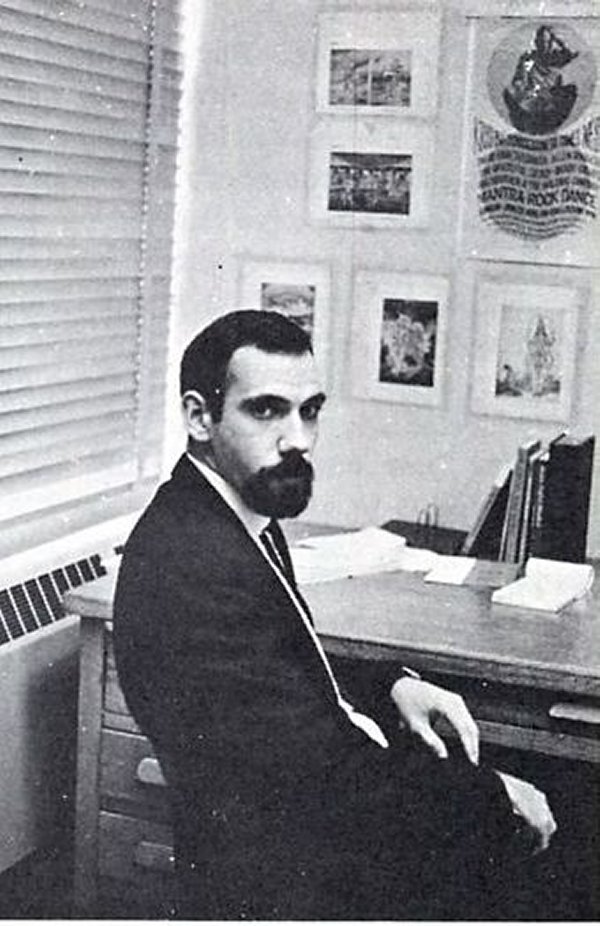
Professor Howard Wheeler (Hayagriva) at his Ohio University office, Columbus, Ohio (c. late 1968 or early 1969). The January 1967 San Francisco Mantra Rock Dance poster hangs on the wall, along with pictures of Krishna and Vishnu.
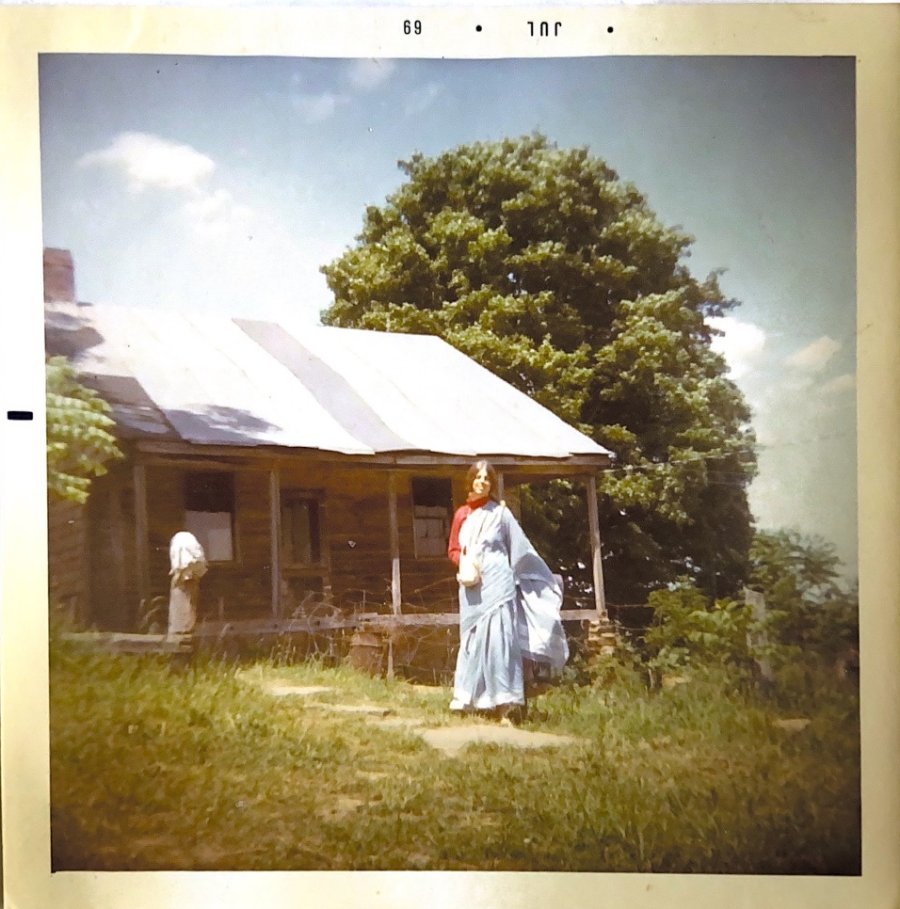
Polaroid photo of Hayagriva’s wife, Cheryl Ann Morris Wheeler (Shama dasi) at New Vrindaban (July 1969).

Polaroid photo of Cheryl Ann Morris Wheeler (Shama dasi) at New Vrindaban (July 1969) (close up).
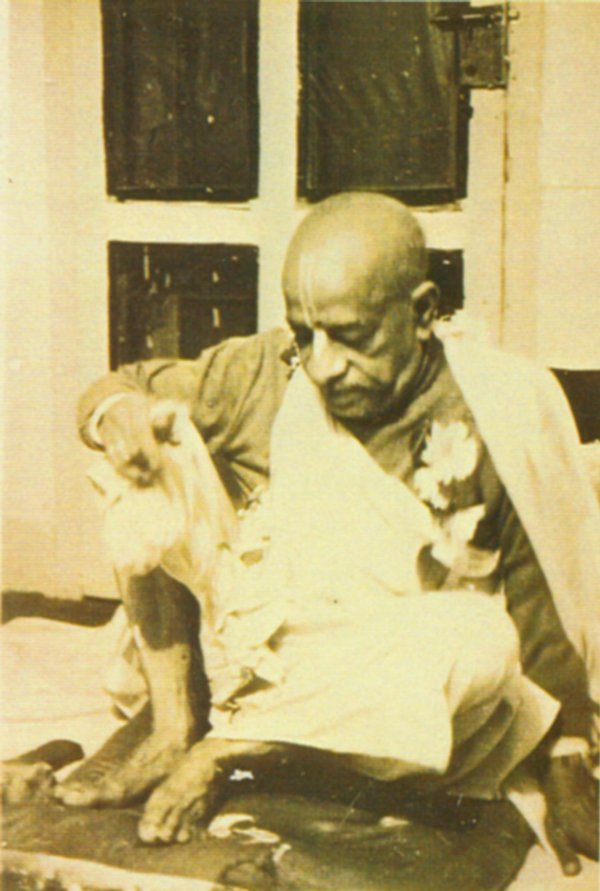
Bhaktivedanta Swami Prabhupada at New Vrindaban (May 1969). Photo by Chintamani dasi.
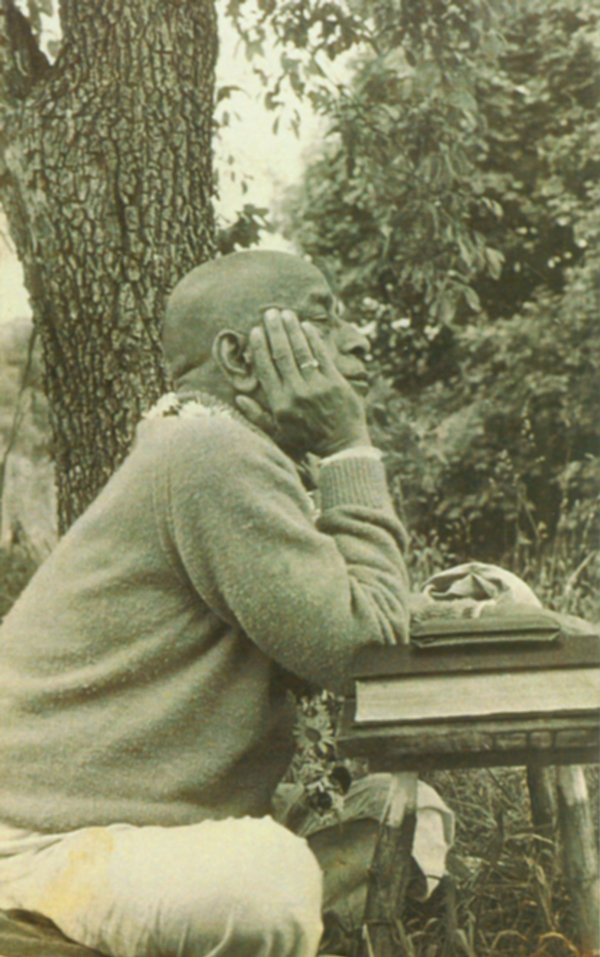
Bhaktivedanta Swami Prabhupada at New Vrindaban (May 1969). Photo by Chintamani dasi.
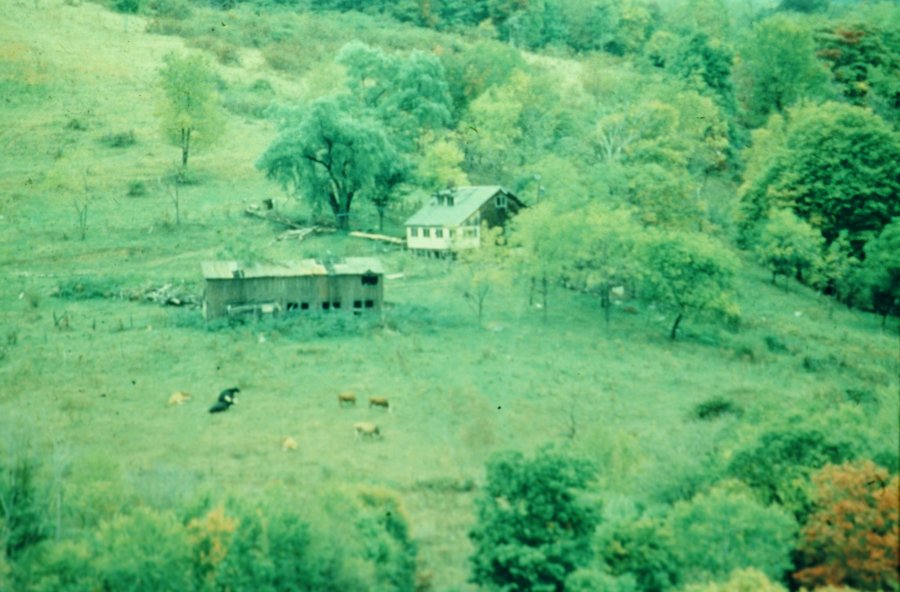
New Vrindaban farmhouse, barn, pasture and seven cows (undated).
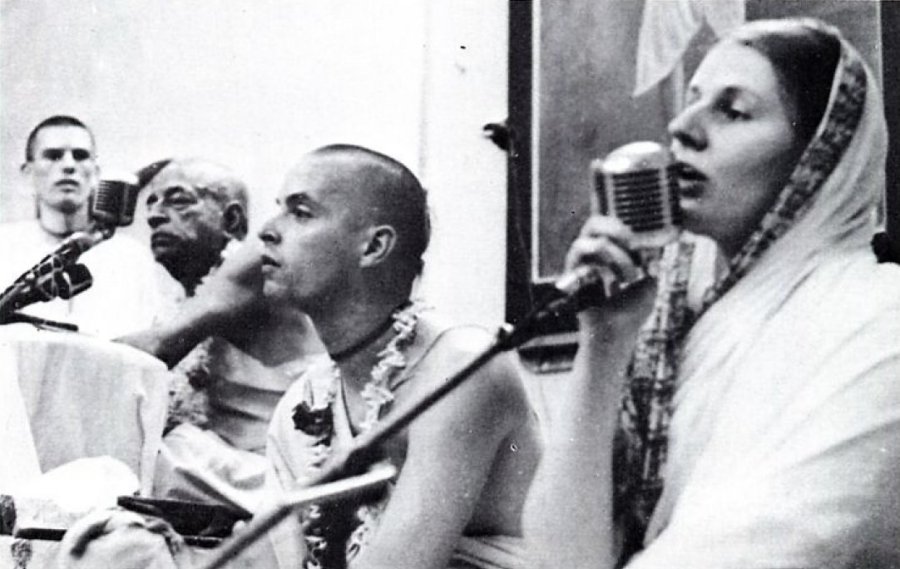
Kirtanananda Swami (center) in India with Bhaktivedanta Swami Prabhupada, Hansadutta dasa, and Hansadutta’s wife, Himavati devi dasi. Photo (autumn 1970) published in Back To Godhead, No. 43, p. 22 (c. January 1971).

New Vrindaban farmhouse, barn and pavilion (c. summer 1971).

The installation ceremony for Radha-Vrindaban Chandra (who are hidden under sheets). Kirtanananda Swami (sitting directly in front of the deities, lower center) presides over the fire sacrifice, while Rupanuga dasa (at right, the GBC representative for New Vrindaban), chants japa with at least forty Brijabasis and guests (August 13, 1971).

Radha-Vrindaban Chandra at Bahulaban (undated).
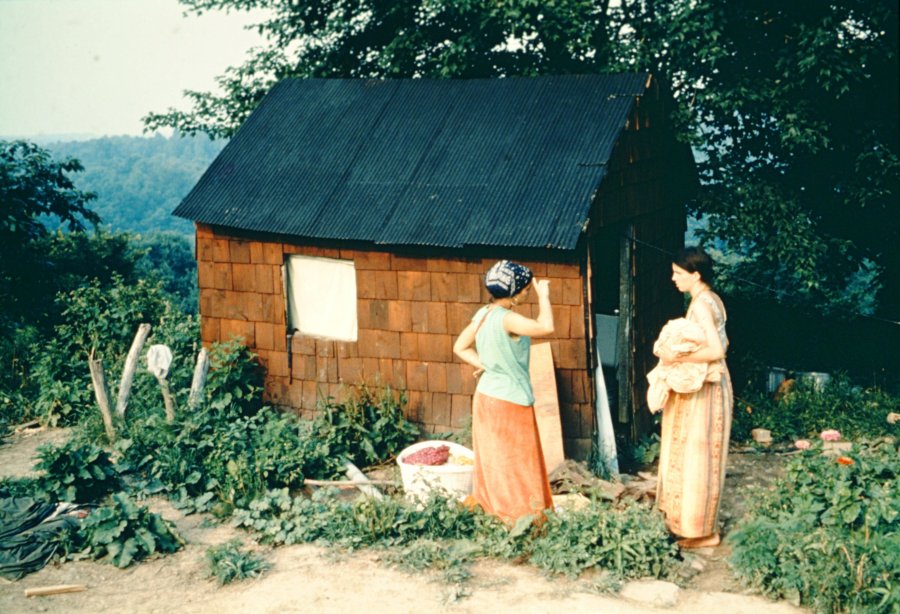
Two female Brijabasis at the Vrindaban farm garden shed (or could it be a residence/cabin?) (undated).
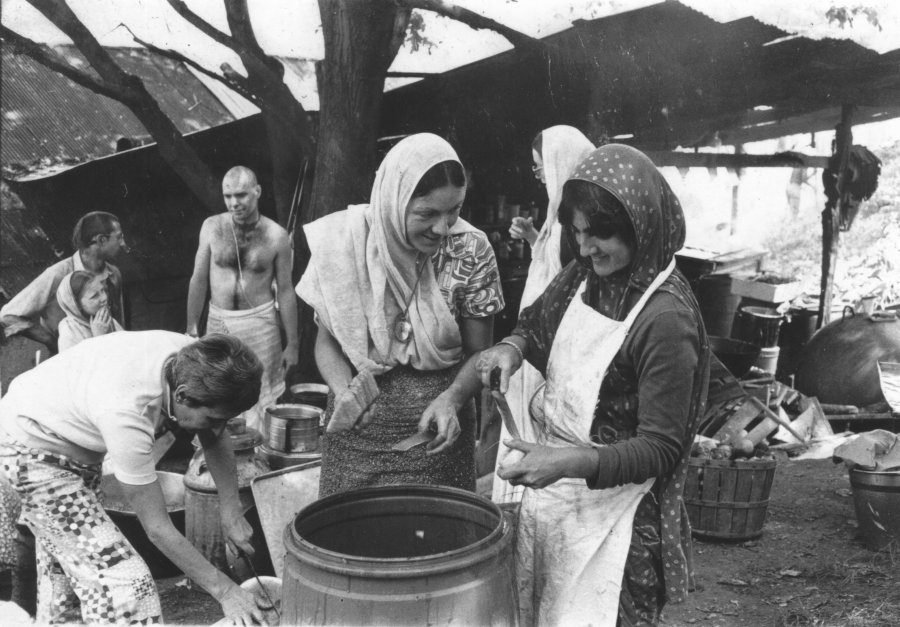
Brijabasis preparing a feast in “The Pits” at Bahulaban (undated).
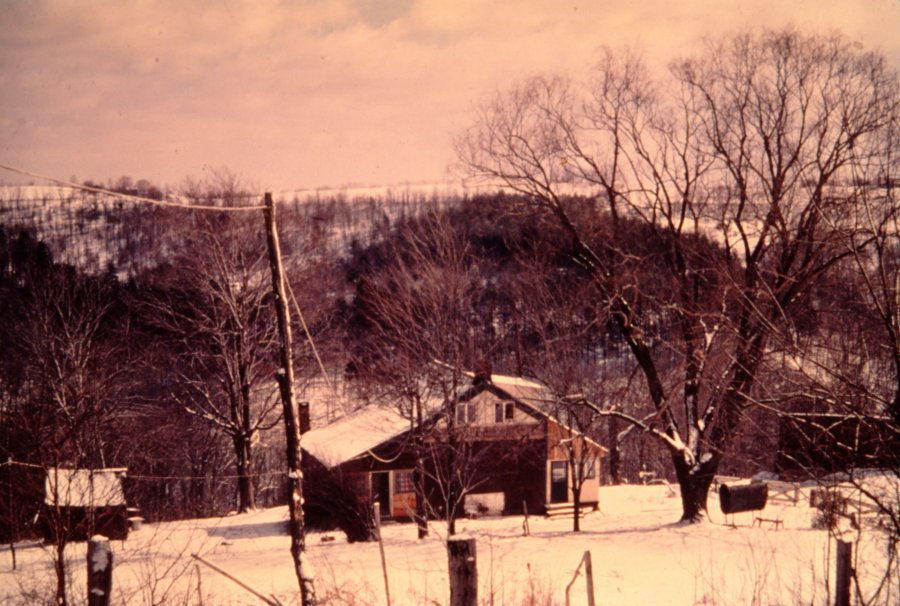
Vrindaban farmhouse in winter (undated, but 1969 or later, after the electric lines were installed).
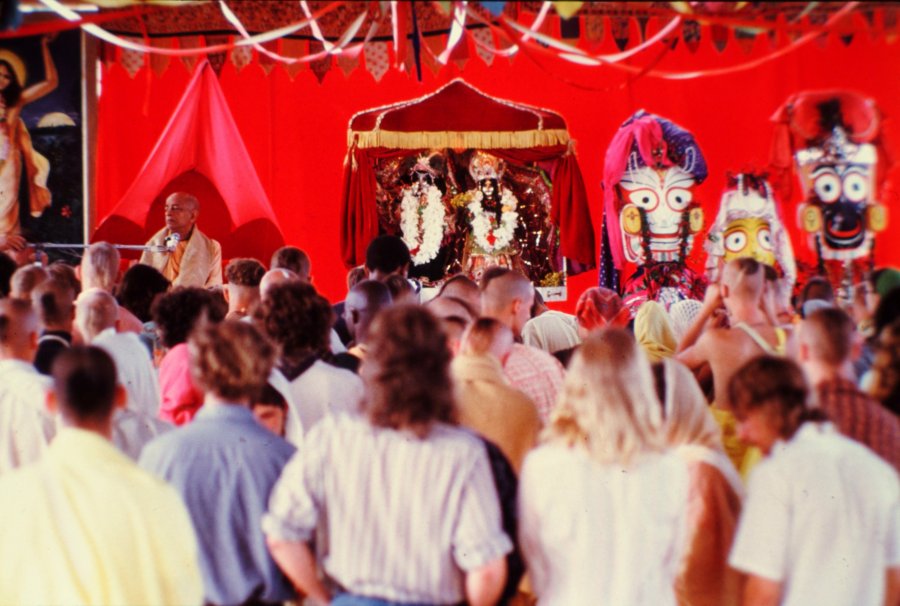
Bhaktivedanta Swami Prabhupada, Radha-Damodar and Balabhadra, Subhadra and Jagannath, in the pavilion on the hill behind Bahulaban (September 1972).
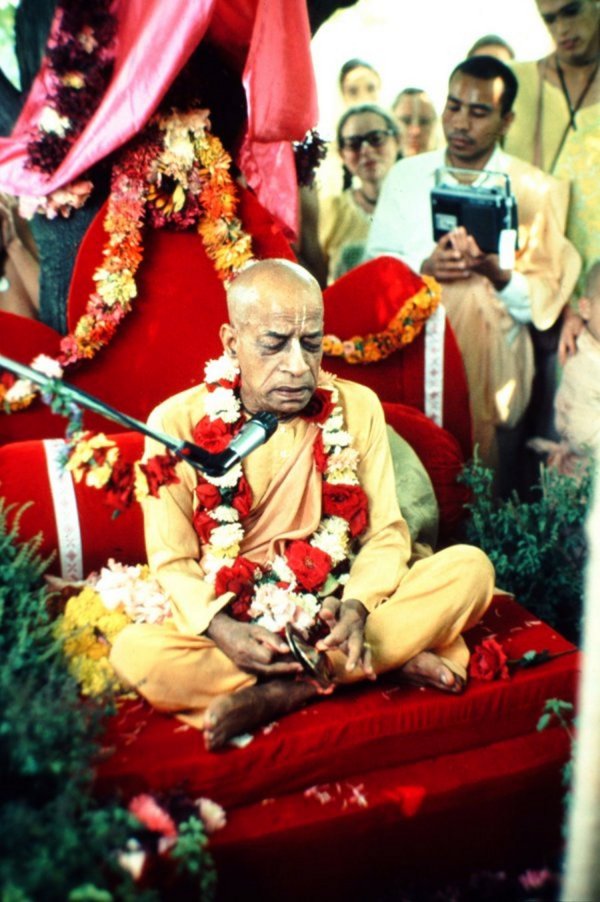
Bhaktivedanta Swami Prabhupada in the pavilion on the hill behind Bahulaban (September 1972).
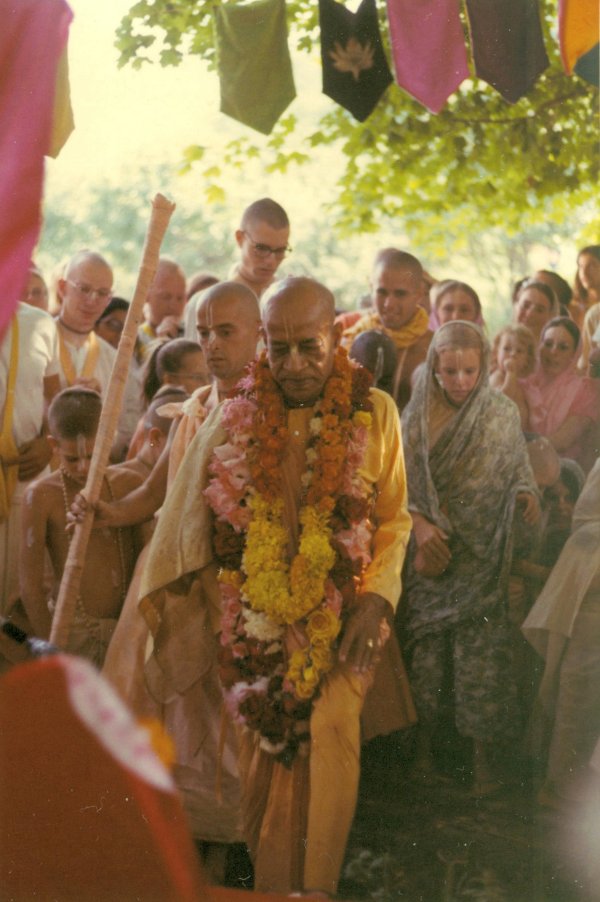
Bhaktivedanta Swami Prabhupada, Kirtanananda Swami (with danda) and disciples at New Vrindaban (September 1972).

Bhaktivedanta Swami Prabhupada at New Vrindaban (September 1972).
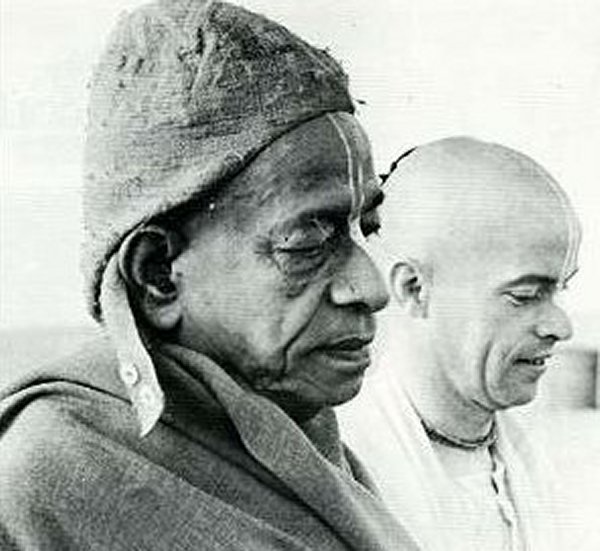
Bhaktivedanta Swami Prabhupada and Kirtanananda Swami (undated).

Kirtanananda Swami plays the tamboura at Pittsburgh ISKCON (1972).
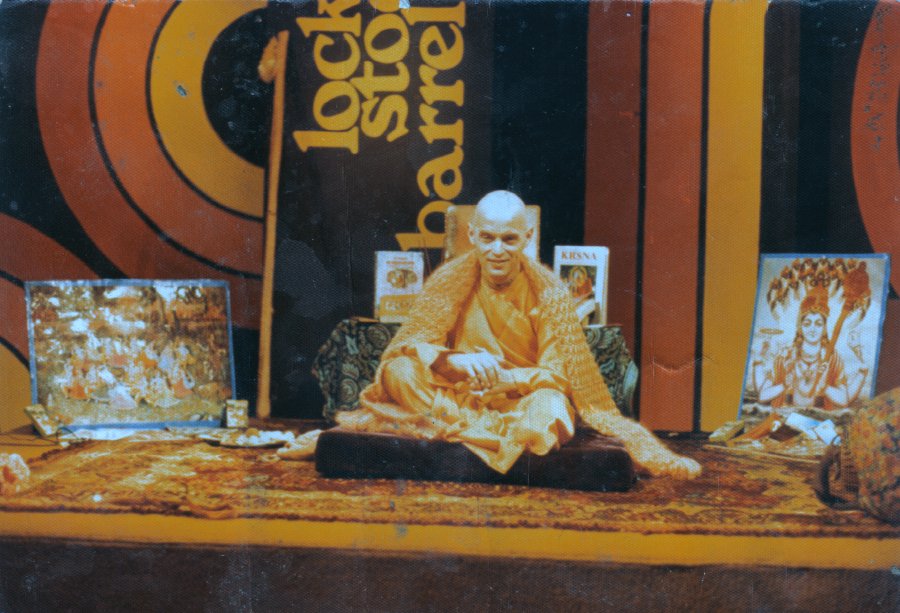
Kirtanananda Swami at a Road Show performance (undated).
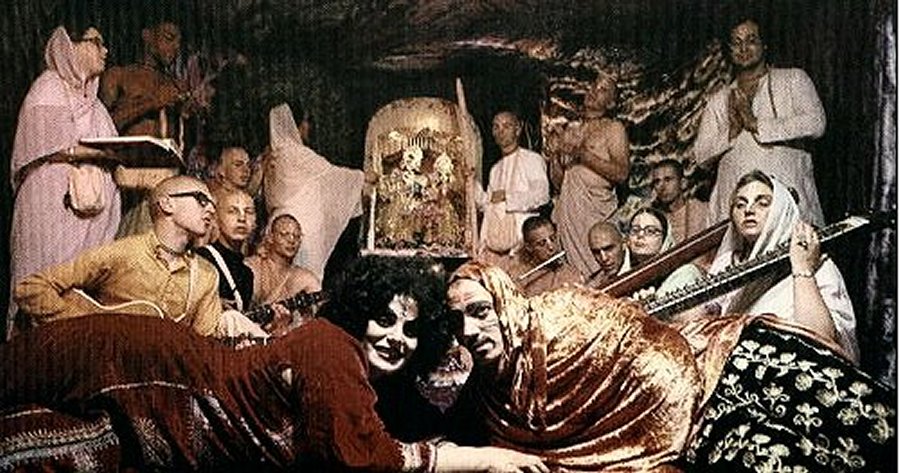
Publicity photo for the Road Show. Vishnujan Swami (with danda) stands near the altar of Radha-Damodar.
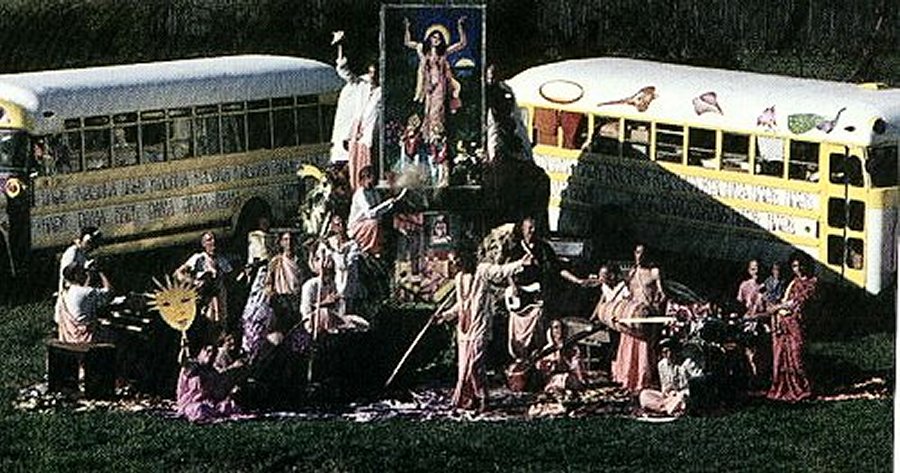
Publicity photo for the Road Show (undated).
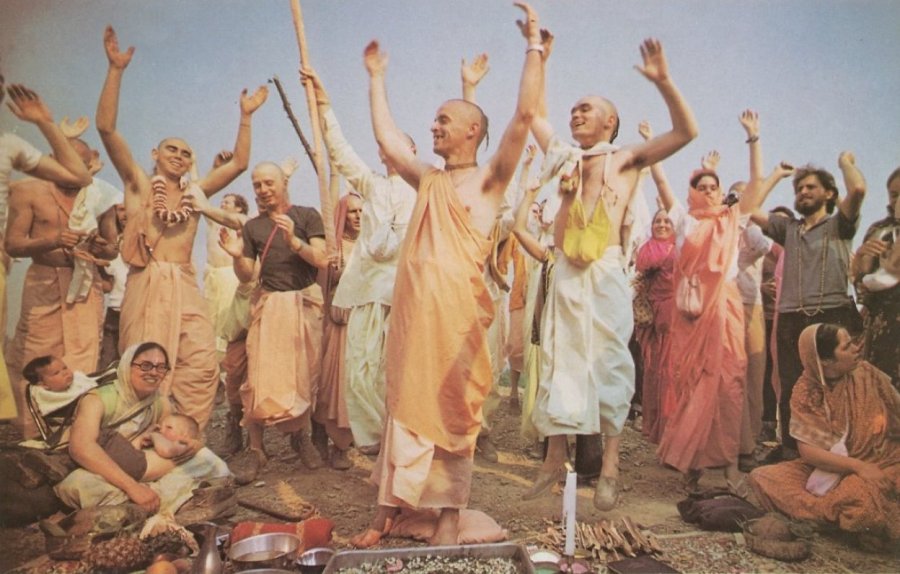
Kirtanananda Swami and devotees at an outdoor New Vrindaban fire sacrifice (summer 1973). Photo from Back To Godhead, No. 66 (c. September 1974).
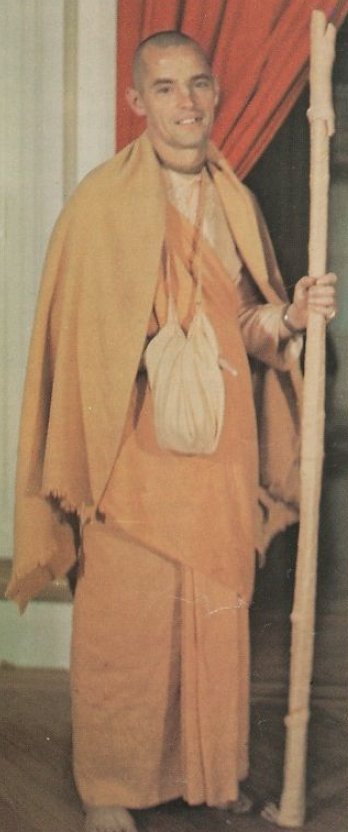
Kirtanananda Swami (undated), photo from Back To Godhead, No. 66 (c. September 1974).

A Brijabasi riding a wagon pulled by two horses at New Vrindaban (summer 1974). Photo from Back To Godhead, No. 66 (c. September 1974).
| Back to: Gold, Guns and God |